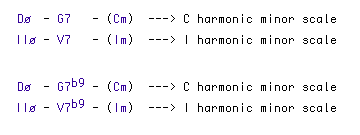(Down - Up - Top)
Im 11.2 - THe IIø - V7 - Im Progressions
The IIø and V7 chords of the harmonic minor scale are extensively used in Jazz and (especially in) Latin music for songs in minor keys or with minor key modulations.
The ImM7 chord, with its minor Major quality, does not function well as a final chord. Instead an minor triad or minor 7th chord is used to complete the so called 'minor II-V-I progression'.
Here are the basic minor II-V progressions :
Audio 11.3

The V7 chord is commonly extended to include the 9th of the chord, which using the notes of the associated harmonic minor scale is a b9.

This V7b9 chord stays entirely within the harmonic minor tonality.
Use the harmonic minor scale of the I chord throughout over the following progressions
Audio 11.4


The Im7 chord does not fit into the Harmonic minor scale, because it contains a b7 instead of a major 7.
Therefore in the following progressions use the harmonic minor (of the I chord) over II and V, but the Dorian mode (of the I chord) over the Im7 chord.
Audio 11.5

|
Another V chord, the V7#9, is sometimes also used in minor chord progressions. This chord requires a special scale for improvisation, the so called 8-note dominant scale (alternating semitone and tone intervals). But the natural minor scale of the I chord also works well in most cases. |
Looking back at Lesson 8 and the song Where there's Rain we can now understand that the G7 chord functions as the V7 scale-tone chord of the C harmonic minor scale. This is clearly more appropriate as the whole song is in the C minor key.
COMMENT
Therefore always beware. A dominant chord is always a V7 chord, but
- whenever it is preceded by a IIm7 chord it is part of a major scale tonality
- but whenever it is preceded by a IIø chord it is part of a harmonic minor scale tonality
Also, as stated in Lesson 10, after a V7 chord anything can happen, just to create some musical suprise.
Therefore you see in quite a number of songs a minor IIø-V7 resolving to a major 1 chord : IIø - V7 - IΔ !!
For example the ending of 'Stella by Starlight' is :
Cø - F7b9 - BbΔ
During the old Classical era a minor chord was not perceived as a final resolving rest point. Therefore musical pieces in a minor key in the end had to resolve (and end) on a major triad chord. This is the socalled Picardi triad.
With our contemporary ears we now do accept a minor chord as a point of rest and an appropriate ending. However in these times the Picardi triad is still used (commonly expanded to a major 7th chord to amplify the effect) as a wonderful harmonic ploy to surprise the listener.
Good examples are :
- Alone Together (ending of A section) - by Dietz & Schwatrz
- Once I Loved (ending of A section) - by A.C. Jobin
- Stella by Starlight - by Victor Young
- What is this thing called Love - by Cole Porter
|